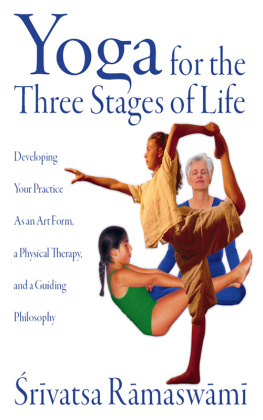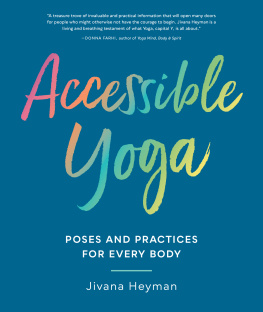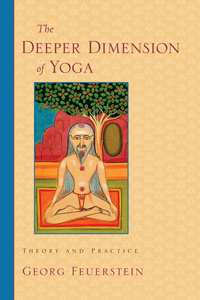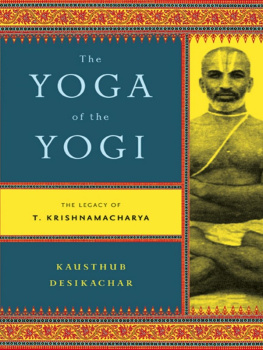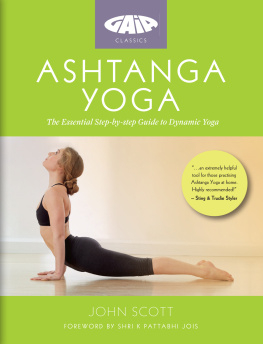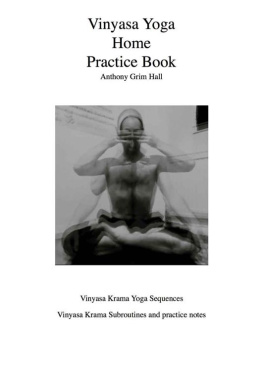
OM
r Rma Jayam
THIS BOOK IS DEDICATED TO the memory of my mother, who said early in my life There is more to life than making a living; to my father, who encouraged me in all my endeavors; to my guru, who had so much to give, and from which I could take so little; and to Lord Almightyr Krirpaamastu.
Acknowledgments

I WISH TO THANK my wife, Dr. Um Rmaswm, for her encouragement and her help, especially with the technical details of writing this book.
I also wish to state my sincere appreciation and thanks to several people who have directly or indirectly helped me to teach yoga and write this book. To my sons Prasanna and Badri, who encouraged me, sometimes like buddies, in the writing of this book and in other yoga activities. They have been a great source of joy.
To the late Rukmini Dev and ankara Menon, former directors of Kalketra Institute, and Mr. Rajaraman, its present director, for the opportunity afforded me to teach there for two decades. To the late M. C. Subramanian of the Public Health Centre for the opportunity to introduce yoga in the hospital. My thanks are due to C. S. Sampath of Public Health Centre Hospital, Professor Janardhanan of Kalketra, S. Chitra of Padma Seshadri Schools, and K. Gopalakrishnan for studying this system and teaching for more than twenty years. To John Coon, the dynamic director, and other senior students and teachers of Yoga Center of Houston, Texas, for studying the vinysakrama in depth and teaching in Houston and elsewhere in the United States, I am grateful. Many students and their students have helped in the development of the book by contributing several of their yoga pictures. They ranged in age from ten to seventy-five and comprised schoolchildren, medical students, physiotherapists, a renowned artist/painter, an athlete, classical Bharatnatyam dancers, teachers, corporate executives, and, of course, a couple of yoga teachers. Girija Menon has done exquisite but difficult postures for the chapter on women and yoga. Pam Johnson, Hilary Nixon, and John Coon have portrayed several sana sequences artistically and with vigor. R. Soundrarajan, M. Parvati, and S. Ramya have done several other yoga sequences beautifully. Others whose pictures appear in the book are C. S. Sampath, Jaya Reddy, Jayashree Soundararajan, R. Sowmya, C. Vidya, Maanasaa, A. Yamini, and Prentis Fatherree. rmn Srinivasan of Krishna Photos shot all the pictures done in Chennai and made special prints of all pictures in this book. To them all, my sincere thanks. To the late r Harigopal Agarwal for the tremendous enthusiasm, encouragement, and opportunities given to me to teach in the huge free yoga camps conducted for nearly ten years at the yoga brotherhood; to Mr. H. M. Mahesh of Sangeetha and Mr. Murali of HMV for producing and marketing my audiocassettes; and to M. Gopalakrishnan, my always optimistic and cheerful cousin, for all his work and support.
To the respected pait r Rjamaiji for the opportunity to give introductory lectures on yoga and workshops and classes at the Himalayan Institute at Hones-dale, and also for the great support; to Sandy Anderson, Mary Gail, and Rolf Sovik, and to Nishit Patel and Virat Xavier for offering introductory programs and workshops and classes in yoga at the Himalayan Institutes in Buffalo, New York, and Chicago; to my cousin Dr. Ambujam, my niece Chitra, and other cousins; to Dr. M. Subramaniam and Mr. M. Hariharan; and to Dr. Sundara Gandhi, Dr. Senthamarai Gandhi, Dr. Sundaraman, Dr. J. L. Sarma, and Dr. Sethuraman, many thanks for hosting and helping me talk about this system of yoga to selected groups. To Professor T. K. Parthasarathy, vice chancellor, and Professor S. Rangaswamy, head of the Holistic Health Center, r Ramachandra Medical University, Chennai, for their efforts to introduce yoga as a program of optional study for both faculty and students of the university, and for the opportunity afforded me to teach there.
My sincere thanks are due also to Kala for the beautiful line sketches she prepared; to Sujay, a senior teacher of the Kriamcrya method of yoga, for her critical input in the writing of this book; to my nephews Dinesh, my Internet provider, and Kartik, my software consultant, for their ready and sustained assistance; and to Professional Touch for their services in having the whole manuscript typed.
My sincere thanks are due to Dr. Nagalakshmi Narayanan of Osmania University, India, for reading through the manuscript and making valuable suggestions, especially in the chapter on Patajali. My thanks are also due to Dr. Laurel Smith for her help and suggestions in making useful changes to the manuscript. Again my thanks are due to Ehud Sperling, president, and Rowan Jacobsen, managing editor, Inner Traditions, for their efforts in publishing the book. I am much beholden to Cannon Labrie for bringing his vast experience and knowledge of Indology and Sanskrit to bear on the editing of the book.
Introduction

MORE BOOKS ON YOGA HAVE BEEN WRITTEN in the past twenty years than ever before, perhaps since Vedic times. It might seem that there would be no need for yet another book on the subject, but I felt that I had something to add to the discussion. My goal is to portray the three aspects of yogaas art, physical therapy, and philosophythat are appropriate for the young, for the middle-aged, and for retirees, in that order. The physical therapy aspects are not discussed separately from various sanas, vinysas, pryma, and chants. It should be mentioned that this book is not a substitute for a teacher or a physical therapist; it is written for general information.
In Yoga Rahasya, Nthamuni refers to the need to take into consideration the individuals stage in life while practicing yoga. The general rule is to follow vddhi, sthiti, and laya kramas (methods) during, respectively, youth, midlife, and old age. When one is young, the body is known as deha, because it grows. At that stage of life, practicing sanas as an art (vinysa) is appropriate. The various sanas and the myriad vinysas, with proper breathing, help the young person grow (vddhi) with good physical and mental health. This aspect is dealt with extensively in several chapters in this book.
During midlife, when there is neither growth nor decay (sthiti), the yoga practice would include important sanas with a few vinysas, good yogic breathing exercises and bandhas (locks), meditation, mantra chants, and so on. These aspects also are covered in this book. In midlife the main requirement is to maintain mental and physical health and ward off diseases. This is the stage when one has to achieve results, discharge heavy responsibilities, and make progress in life. As one gets old, when the body is called arra because it decays, yoga practice will be directed to maintain reasonable mobility, through sana and pryma practice. The laya krama will consist primarily of intense meditation, along with study of, and reflection upon, the philosophy of Yoga. These aspects, too, are given extensive treatment.
But the yogis life is a long journey to kaivalya, or liberation, and could take several life cycles to achieve. While ordinary mortals would cherish the desire to defy death, the yogi wants to defy rebirth. Classical Yoga defines a yogis spiritual evolution as comprising three stages, or levels, and this book is structured accordingly.
Next page
